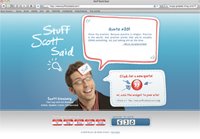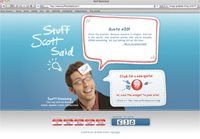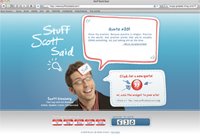 As if you weren’t already assailed with enough negativity, criticism and confrontation from outside sources, I am now going to ask you to start confronting yourself.
As if you weren’t already assailed with enough negativity, criticism and confrontation from outside sources, I am now going to ask you to start confronting yourself.
Ugh. Who wants to do that? People hate confronting themselves.
They’re afraid that they’ll hate what they see.
They’re scared that they’ll have to take responsibility.
They’re terrified that they’ll have to make some changes.
Nah. It’s much easier to turn my eyes outward. I’ll just stick with that, you think.
BUT HERE’S THE SECRET: This isn’t about narcissistic self-obsession.
It’s about confident self-acceptance.
It’s about cementing self-connection.
It’s about conscious self-exploration.
It’s about continuous self-improvement.
As long as you’re wiling to attend to yourself coolly, courageously and compassionately; and as long as you’re willing to do some inner work, self-confrontation is one of the smartest, healthiest practices you could ever embed into your daily life.
Whether you’re an individual – or an organization – here’s a list of six ways (read the next six here!) to confront yourself without condemning yourself:1. Clear the air. I write early. Very early. Sometimes clocking in between three and five in the morning. And the motivation behind this insanity is simple: At that time of day, the world isn’t awake yet.
Which means it’s very quiet. Which means there’s nothing for me to do but listen to the sound of my truth. And that’s when the best material comes spilling out: When your pen is drenched in blood.
That’s all creativity is anyway – active listening. And you don’t have to be a writer to practice this form of self-confrontation. The secret is to clear the air. To create a space where the mental and psychic acoustics are bright, clean and sharp.
Even if you’re not in the mood to listen to yourself. Especially if you’re not in the mood to listen to yourself. That’s probably when you need it most. As long as you promise not to beat yourself up when you hear something you don’t like. How can you eliminate the clatter and invite the clarity?
2. Align with things that will never lie to you. The hardest part about hot yoga isn’t the heat. Or the humidity. Or the fact that you spend ninety minutes in a sweaty room surrounded by half-naked strangers twisting their bodies into positions that would make Cirque du Soleil blush.
The real challenge is the self-confrontation. Did I mention there were mirrors everywhere? And that you have to stare at yourself, in silence, the whole time?
Ugh. Talk about things that will never lie to you. Those mirrors can be brutal. In fact, many first-time students (even some veterans!) can’t hold their gaze for more than a few seconds.
Which makes sense. It takes courage to willingly meet yourself over and over again. And the thought of having to confront your (physical) truth – consistently and objectively for such long periods of time – is one of the reasons many people never come back.
Personally, that’s exactly why I come back. Four days a week. Every week. I crave it like a stoner craves White Castle. Because it’s a chance to align with that which will never lie to me (my body) and force myself to come face to face with my truth.
Even if I’m feeling like a worthless piece of crap. What’s the longest period of time you’ve spent staring at yourself in the mirror?
3. Confront the number. Here’s the smartest weight management strategy I’ve ever practiced: Get on the scale. Every week. Same time. Write down my weight on a chart on the wall. Then look at that number every day.
Lost twelve pounds and kept it off.
Now, here’s what’s fascinating: Depending on how well I ate during the week, I might be excited, terrified or indifferent about confronting the number come Sunday morning.
But I always confront it. No matter what. Without judgment. Without evaluation. Without appraisal. What’s more, sometimes during the week I’ll catch myself mid-bite or mid-meal thinking:
“Damn it. I know I’m going to have to weigh myself in three days. Better pass on that twelfth piece of key lime pie.”
That’s the cool thing about self-confrontation: Even the mere anticipation of confronting your numerical truth can modify choices and behaviors in the meantime.
I wonder what quantitative metrics you could install to your weekly regiment to accomplish the same. Maybe accountability partner phone calls? Written records of activity level? Public charts of progress? How will you confront the number?
4. Use visual reminders. People love to ask me if I wear a nametag to remember who I am. And as facetious as their playful remark usually is, it finally occurred to me a few years ago:
Wait a minute. That’s exactly why I wear a nametag.
Because it’s easy to forget who you are. Sometimes you get so wrapped in who you think you are, who other people think you are, or who you want other people to think you are – that you overlook your own truth.
That’s the benefit of regular self-confrontation: To assist you in getting (and staying) over yourself. To remind you how you roll. And while you don’t need to wear a nametag to do so, you might consider using something tangible as a visual cue to induce ongoing self-confrontation.
As Oriah wrote in The Dance, “Self-acceptance is a practice, a willingness to slowly expand your ability to see yourself as you are and simply be with what you see.” How could you paint yourself into a confrontational corner?
5. Face your monster. You have demons and skeletons just like everyone else. But you also have your main monster. You know the one.
It’s that big, hairy, seven-eyed, ten-legged creepizoid thing hibernating in the deepest recesses of your heart, nagging and biting and scraping and drooling, whose sole purpose of existence is to prevent you from becoming great.
Yes. That one. And like a schoolyard bully, your monster’s power source comes from your fear of him. Which means that, without fear, he can’t touch you.
Which means the first step is to confront him and say, “You don’t scare me anymore.” The cool part is, once you take that first courageous confrontational step, you cripple 80% of your monster’s strength.
Which means that the second (and final) step is to simply take your index finger, poke him in the chest and watch him tumble to the ground like the punk ass he really is. What’s your monster?
6. Turn the tables. “What isn’t part of ourselves doesn’t disturb us,” says Herman Hessee, author of the cult-classic Siddhartha. “And if you hate a person, you hate something in him that is part of yourself.”
Here’s a helpful practice for doing so: Next time you observe someone acting in a manner you don’t approve of, just flip it.
Instead of instantly judging, “Wow, check out this guy at the table next to me. What a putz!” You might think to yourself, “Whom in my life do I treat this way?”
Or, next time something terrible happens to you, ask yourself:
*What is it in me that might be causing this situation?
*What did I do, innately, that attracted this into my life?
*What have I done to contribute to this discomfort I’m now feeling?
Learn to face yourself head on. Then, whatever your truth wants to serve up at that particular moment, accept it without complaint. How can you use your current experience as a mirror?
LOOK, MAN: I know self-confrontation is like pulling teeth – your own teeth. And without Novocain, either.
But if you can’t be honest with yourself, what else is there?
We turn to Joseph Campbell’s book, Reflections on the Art of Living, in which he wrote:
“Where you stumble, there lies your treasure. The very cave you are afraid to enter turns out to be the source of what you are looking for.”
Go meet yourself.
Attend to your truth coolly, courageously and compassionately.
Even if you don’t like what you see.
You’ll thank you.
LET ME ASK YA THIS…
How do you confront yourself?
LET ME SUGGEST THIS…
For the list called, “11 Ways to Become Brilliant By Next Thursday,” send an email to me, and you win the list for free!
Scott Ginsberg
That Guy with the Nametag
Author, Speaker, Entrepreneur, Mentor
[email protected]
 Never the same speech twice.
Never the same speech twice.
Always about approachability.
Watch The Nametag Guy in action here!

 This is all Google’s fault.
This is all Google’s fault. Who’s quoting YOU?
Who’s quoting YOU? You can know the business.
You can know the business. There must be some kind of mistake.
There must be some kind of mistake. Who’s quoting YOU?
Who’s quoting YOU? “Your combination is: One, two, three, four, five? That’s the stupidest combination I’ve ever heard in my life! That’s the kind of thing an idiot would have on his luggage!”
“Your combination is: One, two, three, four, five? That’s the stupidest combination I’ve ever heard in my life! That’s the kind of thing an idiot would have on his luggage!” The world’s FIRST two-in-one, flip-flop book!
The world’s FIRST two-in-one, flip-flop book! “I’m old enough to be your mother!”
“I’m old enough to be your mother!” Who’s quoting YOU?
Who’s quoting YOU? What do Richard Pryor, Whoopi Goldberg, Lorne Michaels, Lily Tomlin, George Carlin, Bill Cosby and Tina Fey all have in common?
What do Richard Pryor, Whoopi Goldberg, Lorne Michaels, Lily Tomlin, George Carlin, Bill Cosby and Tina Fey all have in common? The world’s FIRST two-in-one, flip-flop book!
The world’s FIRST two-in-one, flip-flop book! People use the Internet for one thing – and one thing only.
People use the Internet for one thing – and one thing only. Forget about luck.
Forget about luck. Who’s quoting YOU?
Who’s quoting YOU? Sean Connery was wrong.
Sean Connery was wrong.  The world’s FIRST two-in-one, flip-flop book!
The world’s FIRST two-in-one, flip-flop book!